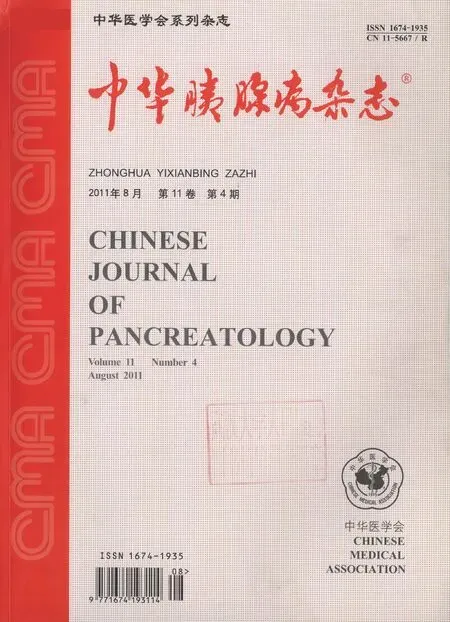斑蝥素對胰腺癌細胞系PANC1、CFPAC-1的凋亡誘導作用及機制研究
李偉 陳政 宗洋 龔斐然 朱毅 殷紅 徐澤寬 陶敏 苗毅
·論著·
斑蝥素對胰腺癌細胞系PANC1、CFPAC-1的凋亡誘導作用及機制研究
李偉 陳政 宗洋 龔斐然 朱毅 殷紅 徐澤寬 陶敏 苗毅
目的研究斑蝥素對胰腺癌細胞系PANC1、CFPAC-1的凋亡誘導作用及機制。方法用斑蝥素處理PANC1、CFPAC-1細胞。四甲基偶氮唑藍(MTT)法檢測細胞增殖;流式細胞術檢測細胞凋亡;酶化學法檢測caspase活性;RT-PCR及蛋白質印跡法檢測凋亡相關基因的表達。結果斑蝥素呈劑量依賴性明顯抑制胰腺癌細胞系PANC1、CFPAC-1增殖及誘導細胞凋亡。10 μmol/L斑蝥素處理細胞72 h,PANC1、CFPAC-1細胞的增殖抑制率最高,分別達(52.95±6.34)%和(71.21±6.30)%。處理24 h,PANC1細胞的早期和晚期凋亡細胞分別從7.35%增加到24.89%、6.36%增加到17.73%;CFPAC-1細胞從6.39%增加到24.70%、9.21%增加到12.58%(P值均<0.01)。PANC1細胞的caspase 8和caspase 9 活性分別為對照組的(155.8±11.5)%和(194.6±14.7)%;CFPAC-1細胞分別為對照組的(182.5±24.3)%和(215.8±12.2)%(P值均<0.01)。促凋亡基因TNF-α、TRAILR1、TRAILR2、Bad、Bak和Bid表達增加,抗凋亡基因Bcl-2表達減少。結論斑蝥素通過激活Caspase、上調促凋亡基因及下調抗凋亡基因的表達從而誘導胰腺癌細胞凋亡。
胰腺腫瘤; 斑蝥素; 細胞凋亡
近年來研究發現,傳統中藥斑蝥的有效成分斑蝥素[1]及其衍生物對包括白血病[2]、肝癌[3]、結腸癌[4]等諸多腫瘤細胞具有顯著抑制作用。臨床上,斑蝥素在治療癌癥,特別是晚期肝癌方面顯示出其獨特的療效[5]。因此斑蝥素有可能應用于胰腺癌,特別是晚期胰腺癌的治療。本實驗觀察斑蝥素對胰腺癌細胞凋亡的誘導作用,探討其分子機制。
材料與方法
一、MTT比色法檢測細胞活力
胰腺癌細胞系PANC1、CFPAC-1購自TCC公司,常規培養、傳代。取對數生長期的胰腺癌細胞接種于96孔板,每孔0.5×104個細胞。培養24 h后分別加入含0、2、4、6、8、10 μmol/L斑蝥素(Biomol公司)處理24、48、72 h,每孔加入5 mg/ml的MTT(Sigma公司)10 μl,37℃孵育4 h,棄培養液,加150 μl DMSO,震蕩至紫色結晶完全消失。用全自動酶標儀測定各孔490 nm處吸光度(A)值。細胞生長抑制率=[(對照組A490值-處理組A490值)/對照組A490值]×100%。半數抑制濃度(IC50)= lg-1[Xk-i (∑p-0.5)]。Xk為設計的最大濃度對數值;i為倍比濃度的對數值;∑p為各組細胞生長抑制率之和;0.5為經驗常數。
二、流式細胞儀檢測細胞凋亡
取對數生長期胰腺癌細胞接種于6 cm培養皿培養24 h,應用0、3、6 μmol/L斑蝥素處理24 h,胰酶消化,收集細胞,采用KeyGen公司的凋亡檢測試劑盒檢測細胞凋亡。按說明書操作。最后上流式細胞儀檢測。
三、細胞caspase 8、caspase 9活性檢測
應用0、10 μmol/L斑蝥素處理細胞24 h,收集細胞,采用caspase 8、caspase 9活性檢測試劑盒(Beyotime公司)測定caspase活性,按說明書操作。用全自動酶標儀測定各孔A405值。 caspase相對活性=(處理組A405值/對照組A405值)×100 %。
四、凋亡調控相關基因表達的檢測
以10 μmol/L斑蝥素分別處理胰腺癌細胞0、1.5、3、6、12、24 h,采用Trizol提取細胞總RNA。用AMV反轉錄試劑盒(Promega公司)進行反轉錄。凋亡調控相關基因的引物序列見表1。RT-PCR法檢測各基因的mRNA表達。

表1 凋亡調控相關基因及所使用的引物序列
收集處理0、6、12、24 h細胞,用冰預冷的細胞裂解液550 mmol/L Tris-HCl[(pH 7.4)、150 mmol/L NaCl、1% Triton X-100、0.1% SDS、1 mmol/L EDTA及蛋白酶抑制劑10 mg/ml leupeptin、10 mg/ml aprotinin、10 mg/ml pepstatin A、1 mmol/L 4-(2-aminoe-thyl) benzenesulfonyl fluoride]裂解細胞,常規蛋白質印跡法檢測凋亡調控相關基因的蛋白表達。抗Bcl-2抗體購自Cell Signaling Technology公司,抗Bad、Bak、TNF-α、TRAILR1、TRAILR2、β-actin抗體均購自Sanda Cruz Biotechnology公司。抗β-actin抗體1∶5000稀釋,其余抗體均1∶500稀釋。最后ECL發光。
五、統計學處理
用SPSS10.0統計學軟件進行分析,不同處理組之間的差異采用成組t檢驗。P<0.05為差異具有統計學意義。
結 果
一、胰腺癌細胞生長抑制率的變化
斑蝥素呈劑量和時間依賴性明顯抑制胰腺癌細胞的生長(表2)。

表2 斑蝥素對胰腺癌PANC1、CFPAC-1細胞的生長抑制率
注:同一細胞系內與24 h點及2 μmol/L濃度組比較,aP<0.05,bP<0.01
二、胰腺癌細胞凋亡率的變化
斑蝥素處理胰腺癌細胞系24 h,早期和晚期凋亡細胞比例呈劑量依賴性增加(圖1)。

圖1 斑蝥素干預后胰腺癌細胞系的凋亡細胞
三、細胞caspase 8和caspase 9活性的變化
10 μmol/L斑蝥素處理胰腺癌細胞24 h,PANC1細胞的caspase 8和caspase 9活性分別為對照組的(155.8±11.5)%和(194.6±14.7)%;CFPAC-1細胞分別為對照組的(182.5±24.3)%和(215.8±12.2)%,均顯著增加(P值均<0.01)。
四、細胞凋亡相關基因表達的變化
斑蝥素處理后,參與外源性凋亡通路的TNF-α、TRAILR1(DR4)和TRAILR2(DR5)的mRNA和蛋白表達水平均增加;參與內源性凋亡通路的促凋亡基因Bad、Bak、Bid的mRNA和蛋白表達水平均增加;而抗凋亡基因Bcl-2的mRNA和蛋白表達水平均降低(圖2)。
討 論
Caspase家族介導凋亡信號轉導[6],主要通過caspase 8介導的外源性凋亡通路(即死亡受體途徑)和caspase 9介導的內源性凋亡通路(即線粒體途徑)[6]。
當胞外死亡配體與細胞表面的受體結合,可激活外源性凋亡通路[6],使參與外源性凋亡通路的諸多配體和受體,如TNF-α、TRAIL1和TRAIL2等的表達明顯上調,其中TNF-α是胰腺癌細胞凋亡誘導因子[7]。在特定的凋亡刺激下,線粒體內膜的一些蛋白被釋放到胞質中,從而激活內源性凋亡途徑[8]。這些蛋白主要是Bcl-2家族成員[8]。

圖2 細胞凋亡相關基因的mRNA(a、b)及蛋白(c)表達
本實驗結果顯示,斑蝥素處理后,PANC1和CFPAC-1的凋亡細胞比例明顯增加,同時caspase 8和caspase 9均被激活,TNF-α、TRAILR1、TRAILR2的mRNA和蛋白表達水平均增加,促凋亡基因Bad、Bak、Bid的mRNA和蛋白表達水平也增加,而抗凋亡基因Bcl-2的mRNA和蛋白表達水平降低,提示外源性和內源性凋亡通路均參與了斑蝥素誘導的胰腺癌細胞凋亡過程,且可能存在一定的交叉。
PANC1和CFPAC-1的TRAIL1和TRAIL2表達水平很低,因此對TRAIL誘導的凋亡很不敏感[9-10],
這可能是胰腺癌對化療不敏感的原因之一。斑蝥素處理后,雖然TRAIL的表達沒有明顯改變,但TRAIL1和TRAIL2的表達顯著增加,從而增加了胰腺癌細胞對TRAIL誘導的凋亡的敏感性,提示斑蝥素有可能會增強其他化療藥物的治療效果,有可能為胰腺癌的治療帶來新的希望。
[1] Wang GS.Medical uses of mylabris in ancient China and recent studies.J Ethnopharmacol,1989,26:147-162.
[2] Huh JE,Kang KS,Chae C,et al.Roles of p38 and JNK mitogen-activated protein kinase pathways during cantharidin-induced apoptosis in U937 cells.Biochem Pharmacol,2004,67:1811-1818.
[3] Chen YN,Chen JC,Yin SC,et al.Effector mechanisms of norcantharidin-induced mitotic arrest and apoptosis in human hepatoma cells.Int J Cancer,2002,100:158-165.
[4] Peng F,Wei YQ,Tian L,et al. Induction of apoptosis by norcantharidin in human colorectal carcinoma cell lines:involvement of the CD95 receptor/ligand.J Cancer Res Clin Oncol,2002,128:223-230.
[5] Ma T,Zhu ZG,Ji YB,et al.Correlation of thymidylate synthase,thymidine phosphoylate and dithydropyrimidine dehydrogenase with sensitivity of gastrointestiral concer cells to 5-fluoroural and 5-flooro-2′-deoxyuridine.World J Gastroenterol,2004,10:172-176.
[6] Riedl SJ,Shi Y.Molecular mechanisms of caspase regulation during apoptosis.Nat Rev Mol Cell Biol,2004,5:897-907.
[7] Kondo J,Sato F,Kusumi T,et al.Claudin-1 expression is induced by tumor necrosis factor-alpha in human pancreatic cancer cells.Int J Mol Med,2008,22:645-649.
[8] Youle RJ,Strasser A.The BCL-2 protein family: opposing activities that mediate cell death.Nat Rev Mol Cell Biol,2008,9:47-59.
[9] Hesry V,Piquet-Pellorce C,Travert M,et al.Sensitivity of prostate cells to TRAIL-induced apoptosis increases with tumor progression:DR5 and caspase 8 are key players.Prostate,2006,66:987-995.
[10] Mori T,Doi R,Toyoda E,et al.Regulation of the resistance to TRAIL-induced apoptosis as a new strategy for pancreatic cancer.Surgery,2005,138:71-77.
2010-08-11)
(本文編輯:呂芳萍)
CantharidininducesapoptosisinpancreaticcancercelllinesPANC1andCFPAC-1
LIWei,CHENZheng,ZONGYang,GONGFei-ran,ZHUYi,YINHong,XUZe-kuan,TAOmin,MIAOYi.
DepartmentofOncology,FirstAffiliatedHospital,SoochowUniversity,Suzhou215006,China
XUZe-kuan,Email:xuzekuan@njmu.edu.cn;TAOmin,Email:mtao@medmail.com.cn
ObjectiveTo investigate the apoptosis induction effect of Cantharidin on pancreatic cancer cell line PANC1 and CFPAC-1 and possible mechanism.MethodsPANC1 and CFPAC-1 was treated with Cantharidin. Cell growth was determined by MTT. Apoptosis was measured by flow cytometry. Caspase activity was measured by using enzyme chemical method. Apoptosis-related gene expressions were determined by using RT-PCR and Western blotting.ResultsCantharidin significantly inhibited the growth of pancreatic cancer cells PANC1, CFPAC-1 and induced apoptosis in a dose-dependent manner. Seventy-two hours after 10 μmol/L Cantharidin treatment, the inhibitory rates of PANC1, CFPAC-1 were (52.95±6.34)% and (71.21±6.30)%. Twenty-four hours after treatment, the early and later period apoptotic cell of PANC1 was increased from 7.35% to 24.89%, from 6.36% to 17.73%. The early and later period apoptotic cell of CFPAC was increased from 6.39% to 24.70%, from 9.21% to 12.58%(P<0.01). Activity of caspase 8 and caspase 9 in PANC1 cells was (155.8±11.5)% and (194.6±14.7)% when compared with that of control group. Activity of caspase 8 and caspase 9 in CFPAC-1 was (182.5±24.3)% and (215.8±12.2)% when compared with that of control group (P<0.01). The expression of pro-apoptotic genes, TNF-α, TRAILR1, TRAILR2, Bad, Bak and Bid was elevated, the expression of anti-apoptotic Bcl-2 gene was decreased.ConclusionsCantharidin can induce apoptosis in pancreatic cancer cell lines by activating caspase,up-regulating the expression of pro-apoptotic genes and down-regulating the expression of anti-apoptotic genes.
Pancreatic neoplasms; Cantharidin; Apoptosis
10.3760/cma.j.issn.1674-1935.2011.04.008
國家自然科學基金(30872509);江蘇省“六大人才高峰”項目[2007200(EI07)]
215006 蘇州,蘇州大學附屬第一醫院腫瘤科(李偉、殷紅、陶敏),血液科(龔斐然);南京醫科大學第一附屬醫院普外科(李偉、陳政、宗洋、朱毅、徐澤寬、苗毅)
徐澤寬,Email:xuzekuan@njmu.edu.cn;陶敏,Email: mtao@medmail.com.cn

